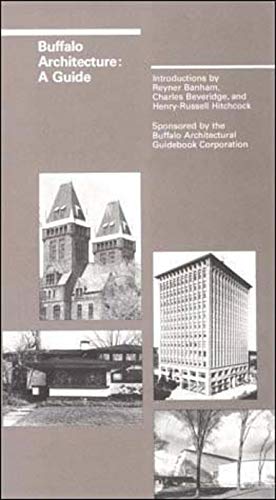reyner banham architectural guideboo buffalo (1 resultados)
Tipo de artículo
- Todo tipo de artículos
- Libros (1)
- Revistas y publicaciones
- Cómics
- Partituras
- Arte, grabados y pósters
- Fotografías
- Mapas
-
Manuscritos y
coleccionismo de papel
Condición
- Todo
- Nuevos
- Antiguos o usados
Encuadernación
- Todo
- Tapa dura
- Tapa blanda
Más atributos
- Primera edición
- Firmado
- Sobrecubierta
- Con imágenes del vendedor
- Sin impresión bajo demanda
Ubicación del vendedor
Valoración de los vendedores
-
Buffalo Architecture: A Guide
Publicado por MIT Press (MA) October 1981, 1981
ISBN 10: 026252063XISBN 13: 9780262520638
Librería: Hennessey + Ingalls, Los Angeles, CA, Estados Unidos de America
Libro
Trade Paperback. Condición: Used - Very Good. For its size, the city of Buffalo, New York, possesses a remarkablenumber and variety of architectural masterpieces from the late nineteenth and earlytwentieth centuries: Adler and Sullivan's Prudential building, H. H. Richardson'smassive Buffalo State Hospital, Richard Upjohn's Sr. Paul's Episcopal Cathedral, five prairie houses by Frank Lloyd Wright, and building by Daniel Burnham, AlbertKahn, and the firms of McKim, Mead, and White, and Lockwood, Green and Company, among others.These structures by prominent 'outsiders' served to spur the efforts oflocal architects, builders, and craftsmen, and all of them built within the contextof the city-wide park and parkway system designed by Frederick Law Olmsted. Inaddition, the city and its environs exhibit representative works by more recentarchitects, among them Eero and Eliel Saarinen, Walther Gropius, Marcel Breuer, PaulRudloph, Minoru Yamasaki, and the firm of Skidmore, Owings, and Merrill.Buffalo'srich architectural and planning heritage has attracted the attention of severalprominent historians, capable of the challenge of evaluating its significance.Reyner Banham is one of the world's leading authorities on the theory and practiceof architecture, and he has written extensively on design in the industrial age (andBuffalo's innovative manufacturing plants and grain elevators are importantexemplars of such design). Charles Beveridge, whose essay covers the park andparkway system, is editor of the Olmsted papers at The American University. AndHenry Russell Hitchcock is the dean of American architectural historians, and theorganizer of a 1940 exhibition on Buffalo's built environment.Their essays arefollowed by seven sections that delineate the city's neighborhoods, each providedwith a map, neighborhood history, and a full complement of photographs withdescriptive building captions. An eighth section, 'Lost Buffalo,' describesdemolished buildings, chief among them Wright's great Larkin administrationbuilding, while the remaining sections venture out of town, wxploring Erie andNiagra Counties, other parts of Western New York, and southern Ontario. Buffalo's rich architectural and planning heritage has attracted the attention of several prominent historians, whose work here is accompanied by over 250 illustrations and photographs. Used copy with light wear.


